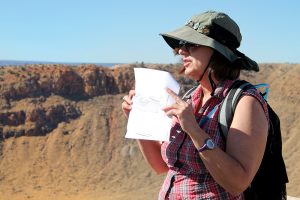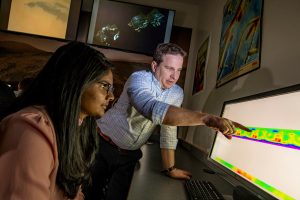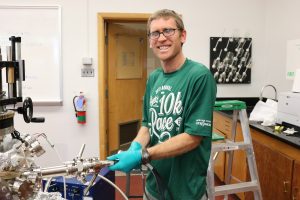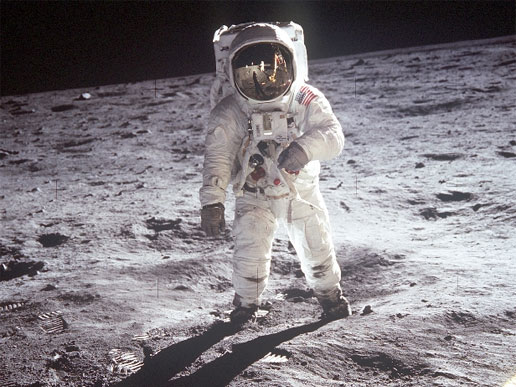By Heidi Toth
NAU Communications
Is there life on the Moon?
On July 20, 1969, there was—in the form of astronauts Neil Armstrong and Buzz Aldrin walking on the Moon. And while U.S. scientists have not yet found evidence of lunar life, much of the focus of today’s research is how we can put people back on the Moon, this time more permanently, including building a lunar base and using that infrastructure to launch missions further into the solar system.
Knowledge of the Moon has meant a lot of small steps by hundreds of scientists and engineers throughout the world. In honor of this anniversary, NAU News talked to three professors in the Department of Physics and Astronomy at Northern Arizona University about the research they’re doing related to the moon and how everything we learn about Earth’s nearest neighbor teaches us more about the history and creation of the Earth itself.

Nadine Barlow: Craters on the Moon
Barlow, who is chair of the department, studies impact craters, examining the differences in structures formed when an asteroid hits a planet and how atmosphere, the planet’s crust and other factors affect the crater.
“The nice thing about impact craters is we know the basic structure that impact craters have when they form,” she said. “Crater formation is a pretty typical process. There’s a really nice relationship between the depth of the crater and its diameter, and those types of things seem to be pretty consistent from one location to another.”
A big part of her work focuses on the differences in craters between different types of planets. Mercury and Mars, for example, have a similar gravity but have different surface strengths, are different sizes and have different geologic processes working on the planet, so while the craters form in the same way, a dozen factors make the result different on these two planets. And throw Earth in there, which has strong gravity, a significant atmosphere, lots of known weather conditions and 7 billion humans, and the nice, controlled process can create some unusual results.
The Moon, insofar as it can, provides a control of sorts. It has no atmosphere, no recent volcanic activity, little current seismic activity, no water—none of the typical causes of erosion.
“The Moon is really our stepping stone, if you will, to understanding what else is going on in the solar system,” Barlow said. “It’s basically a geologically dead body that hasn’t been active for 3 billion years—no atmosphere, no liquid water, no glaciers to mess things up. By looking at the craters on the Moon and understanding their basic structures, that’s how we can then go ahead and look at other bodies and say, ‘Something weird is going on here.’
“The Moon is really useful because it’s a really good comparison. We can look at it and see how things behave without all these other things happening, all these other processes going on.”
Scientists also have access to more and better data about the Moon than was available decades ago, Barlow said, so they’re revisiting questions they thought had already been answered. High-resolution images from the Lunar Reconnaissance Orbiter and gravity data from NASA’s Gravity Recovery and Interior Laboratory (GRAIL) mission have allowed researchers to obtain more detailed views of surface features, pick up slight variations on terms of mass distribution and get a better idea of the surface topography and subsurface structure of the Moon, which is providing new insights into the formation of peak ring craters, one of Barlow’s focus areas.
The renewed interest in the Moon is even giving scientists a better idea of how it formed, which offers a look at the Earth’s evolution as well.

Christopher Edwards: Water on the Moon
Assistant professor Edwards runs the Mars Rover Operations and Analysis lab, and much of his research looks at the Red Planet. To gain a better understanding of Mars, though, he needs a comparative planetary body other than Earth. The Moon is a good foil.
“You can get this glimpse into these early solar system processes that are erased from Earth,” he said.
His recent lunar-related findings argue against the hypothesis that water is migrating around the Moon as evidenced by spectral features changing based on time of day. He and his co-principal investigator found those spectral features didn’t actually vary; what showed up as variance was actually just a function of the corrective action needed to account for light being both reflected off and emitted from the surface.
There are “volatiles” on the Moon—either water or OH, he said. However, they are present in miniscule quantities, it seems at this point, and researchers aren’t yet sure what else that signifies. This fall, Edwards also will be working with a graduate student who will examine different terrains on the Moon and see if those terrains provide any hints as to where to find these volatiles. Their presence could be connected to impact craters, volcanic deposits or solar wind, each of which tells a different story about where to find OH or water.
“It gives us a better idea of the history of the Moon,” Edwards said. “This can help us refine its evolution through time.”
His other interest in Earth’s nearest celestial neighbor relates to permanent ice shadow regions, also known as cold traps. Because the Moon isn’t tipped on its axis like Earth is, there are locations on it that never get any sunlight. They’re colder than -350 degrees Fahrenheit. Water left by passing comets may get into traps and freeze, creating these ice deposits on the Moon. Although instruments have studied large ice traps at the Moon’s poles, Edwards proposed an instrument that could get to smaller cold traps and measure the volatiles on the Moon.
Volatiles are critical not only to learn about the Moon but also for humans’ uses for the Moon. Edwards said much of science right now is focused on using resources on the Moon to further our ascent into the solar system. Rocket fuel is heavy and Earth has a strong gravitational pull, but if we could make fuel and lift off from the Moon, which has less gravity, human exploration of the far reaches of the solar system could be within reach.
It’s still a ways off, he acknowledged, but interesting to consider what opportunities are out there.

Mark Loeffler: Surface of the Moon
Not even the Moon can stay dust-free after a windy day.
Dust, for being as small as it is, has played a significant role in the evolution of the Moon’s surface, said Loeffler, an associate professor. Dust particles hit the surface of the Moon traveling at tens of kilometers per second, fast enough to vaporize the material they interact with and often themselves in the process.
Scientists think these micrometeorite impacts have altered the properties of the Moon’s surface over time. Regolith, the powdery material on the surface of the moon, is thought to be processed by these impacts, with its composition, optical and chemical properties and particle structure changing. Just underneath the surface, though, the layer is unaffected by these impacts.
Loeffler, who studies planetary surfaces, is examining the effects of these impacts on the surface of the Moon and asteroids. He does that by using a pulsed laser to simulate the particle striking the surface of a rock similar in composition to what would be found on the Moon.
“You fire the laser up and it shoots a pulse of energy that lasts four to six nanoseconds, which ends up melting and vaporizing the sample surface, similar to what a fast dust particle would do,” he said.
It’s not a perfect replication of the impact, as the micrometeorite can cause other alterations, but it appears to do a good job replicating what has been observed in lunar soils.
This work is motivated by early observations of lunar soil, which compare moon rocks and moon dirt that have been crushed to similar grain sizes in the laboratory. Even if these materials have the same overall composition, they have completely different spectra. This difference is almost certainly because of this process of space weathering—particles hitting the small soil grains alter them throughout, while the larger rocks are only affected on the surface, so the core of the rock remains unchanged.
“The whole large-scale theme is to try to really understand how the Moon’s surface has evolved over time and can these impacts play a role in that,” Loeffler said. “That’s the idea, to help us understand the evolution of the Moon and our solar system in general and what processes make up our solar system. A lot of times those processes are really slow, but knowing the importance of micrometeorite impacts, versus other things such as solar wind, can tell you a lot about what’s important in other parts of the solar system as well.”



